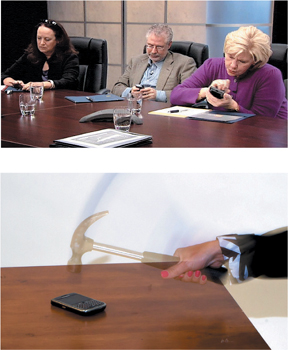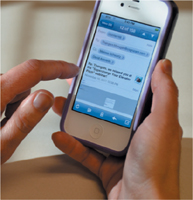CHAPTER
5
Disengaged Executives:
It’s You or the Smartphones
Type A personalities have short attention spans. They get bored. So you’ve got to keep moving. Pace is as critical as content.
—Dan Warmenhoven
Julie Patel, Senior Director, Elan Pharmaceuticals, was just three minutes into her presentation when she noticed out of the corner of her eye that several executives were fiddling with their smartphones. She ignored it. She certainly had plenty else to worry about in this critical presentation. She thought to herself, “Surely this will pass. They must see how important it is that we move ahead on this proposal.”
Things got worse. No one seemed to be paying attention as Julie continued, “Our leaders need this program in these tough economic times. We’re not able to compensate people appropriately.” The executives ignored her as they continued to text and talk on their phones.
Frustrated, Julie suddenly imagined pulling a hammer out of her briefcase and smashing all the executives’ smart-phones as she shouted, “Maybe now you’ll pay attention!”

Pure fantasy. It was all a dream.
The second deadly challenge requires making sure from the beginning that the executives are engaged, then keeping them engaged, and drawing them back in if they become distracted. Finally, if none of that works, you need to get your sponsor involved. (We’ll talk more about the crucial role of your sponsor in Chapter 11.)

Julie Patel
Disengaged Executives
“It’s been a rough day.”
With a 21-year career in HR functions with companies involved in the life sciences, Julie Patel has worked on several organization change integrations developing talent through mergers and acquisitions. She works to ensure that human resource strategies are consistent with business objectives. She cares deeply about the human side of the business.
Julie went into the senior-level meeting hoping to get a commitment for investment in the company’s key talent at a cost of $200,000. As the senior team got more and more distracted with emails and their cell phones, she felt increasingly disheartened. “I really need your support and attention on this,” she pleaded. The executives remained engaged with everything except her proposal.
Julie’s first mistake was that she failed to get and hold their attention. She needed to start by confirming the value of the topic as well as the time allotted, and then get to the point quickly to keep executives engaged. When they became distracted, she should have done a process check, i.e., reconfirmed the agenda.

Julie’s next mistake was assuming that the executives had tuned her out just because they were looking at their cell phones instead of at her. Many executives have turned multitasking into an art form. They can check their smartphone, look at their computer, and hear what you’re saying all at the same time.
Finally, Julie could have used her sponsor’s help to reengage everyone because the sponsor can address the group in a way she cannot.
When it was over, back in her office, Julie stared off into the distance. “It was a disaster. Because of my lack of impact with them, they’re going to miss the opportunity to do something powerful for the employees. For all the preparation, and the time of everyone in the room, and to not get the outcome I wanted … Well, it’s been a rough day.”
Executive Advice
Get engagement. That’s what you’re looking for. If you don’t have it at the beginning, stop and get it. If you never get it, go home.
—Brenda Rhodes
If your audience seems to be disengaged, one of two things may be happening: 1) They are, in fact, distracted and not paying attention to your presentation; or 2) They are using their computers or other devices to do something that relates to the information you’re presenting, i.e., jotting down an important point you made or calling a colleague to invite them to the meeting. So, don’t jump to conclusions. They may in fact be in support of your proposal.
—Felicia Marcus
If you can connect your problem with what we’re trying to do, that gets our attention much faster.
—Mike Lyons
Still Relevant?
Julie’s second presentation went much better. Upon noticing that the executives all seemed checked out, instead of giving up, she asked for a verbal confirmation (a process check) to confirm that the agenda was still important. “Is this still a relevant topic? Should I continue or does something else need to happen here?” Her question forced the executives to make a conscious decision about where the meeting was going. The one-two punch helped recapture their attention.
She also enlisted her sponsor’s help, a plan they had already agreed upon should things get rough. That helped re-engage the executives and made for a much more successful outcome.
After it was over, Julie said, “It went much better this time. I read the room, did a process check, and brought in my sponsor for help. Bottom line, the group was bought in. They were engaged. They were interested. They were asking questions, and I got what I wanted!”
Summary
To avoid the traps of Disengaged Executives:
• Make sure you confirm the topic and time up front, and get right to your bottom line request
If you notice the executives are losing focus:
• Don’t make assumptions about what’s happening
• Read the room and take action
• Re-engage with a question
• Do a process check confirming the value of the topic
• Enlist your sponsor’s help
